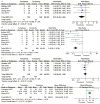Tenotomy or tenodesis for the long head of biceps lesions in shoulders: a systematic review and meta-analysis
- PMID: 25786125
- PMCID: PMC4364971
- DOI: 10.1371/journal.pone.0121286
Tenotomy or tenodesis for the long head of biceps lesions in shoulders: a systematic review and meta-analysis
Abstract
Background: Both tenotomy and tenodesis have been widely used for the treatment of long head of biceps tendon (LHBT) lesions, but the optimal strategy remains considerably controversial. In this meta-analysis of published studies, we compared the results of the two procedures.
Methods: A literature search that compared tenotomy with tenodesis was performed using MEDLINE, and Embase until August 2014. A total of 7 studies reporting data on 622 subjects were included. Study quality was evaluated using the PEDro critical appraisal tool and the NO quality assessment tool.
Results: Data synthesis showed higher functional outcomes, a lower complication rate, and longer surgical time in patients managed with tenodesis compared to tenotomy (Constant score, P = 0.02; Popeye sign, P < 0.001; cramp pain, P = 0.04; surgical time, P < 0.001, respectively).
Conclusion: This meta-analysis indicates that tenodesis results in better arm function and lower incidences of cramp pain and Popeye sign in LHBT lesions, while the procedure required longer surgical time compared to tenotomy. More sufficiently powered studies would be required to further determine the optimal strategy.
Conflict of interest statement
Figures



References
-
- Rodosky MW, Harner CD, Fu FH (1994) The role of the long head of the biceps muscle and superior glenoid labrum in anterior stability of the shoulder. Am J Sports Med 22: 121–130. - PubMed
-
- Yamaguchi K, Riew KD, Galatz LM, Syme JA, Neviaser RJ (1997) Biceps activity during shoulder motion: an electromyographic analysis. Clin Orthop Relat Res: 122–129. - PubMed
-
- Kim SH, Ha KI, Kim HS, Kim SW (2001) Electromyographic activity of the biceps brachii muscle in shoulders with anterior instability. Arthroscopy 17: 864–868. - PubMed
-
- Itoi E, Kuechle DK, Newman SR, Morrey BF, An KN (1993) Stabilising function of the biceps in stable and unstable shoulders. J Bone Joint Surg Br 75: 546–550. - PubMed
Publication types
MeSH terms
LinkOut - more resources
Full Text Sources
Other Literature Sources

